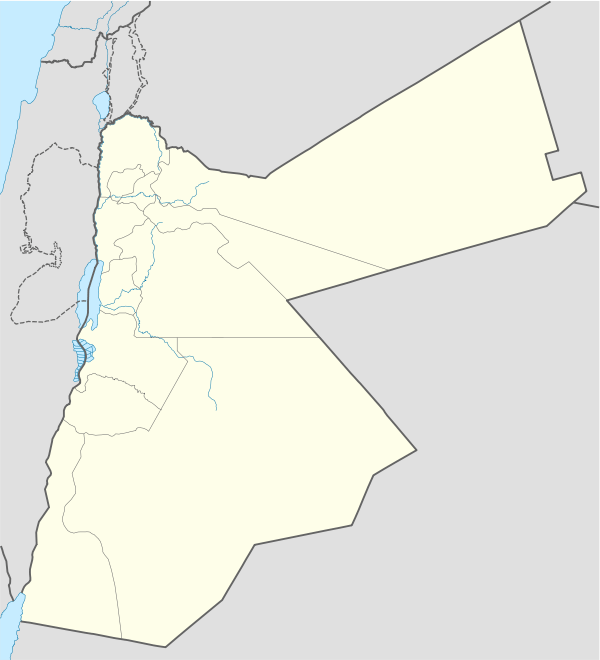Bozrah
| Busaira بلدة بُصرة Bozrah | |
|---|---|
| Town | |
|
The ruins of Bozrah, the capital of Edom | |
 Busaira | |
| Coordinates: 30°42′50″N 35°39′29″E / 30.71389°N 35.65806°E | |
| Country | Jordan |
| Province | Tafilah Governorate |
| Founded | 1100 B.C. |
| Government | |
| • Type | Municipality |
| • Mayor | Mazen Refoo |
| Time zone | GMT +2 |
| • Summer (DST) | +3 (UTC) |
| Area code(s) | +(962)3 |
Botsra, Botzrah, or Bozrah (Arabic: بُصَيْرا, translit. buṣayrā; Hebrew: בָּצְרָה, translit. boṣrah) is a historical site and modern village in Tafilah, Jordan (between Tafilah (Tophel) and Shoubak and closer to the latter). It is identified by some researchers to be the one mentioned in the biblical narrative. The site is adjacent to the modern town of Bouseira (Arabic: بصيرا), (alternatively Buseirah or Busairah).
Excavations and finds
Excavation of the site began in the 1970s, the finds were dated first to the 8th century BCE.[1] However, later studies indicated that the main excavated sites there, including Umm el-Biyara, Tawilan and Buseirah, do not pre-date the seventh century B.C. (Iron II).[2] A round of excavations was conducted in 2009 and resulted in uncovering a church, possibly Byzantine, dwellings, and some water wells.[3] An old tomb is popular among tourists as it is said to belong to Al-Harith Bin Umair Al-Azadi [4] whose murder lead to the 639 CE Battle of Mu'tah.
History in Biblical Narrative
Bozrah was the capital city of Edom. According to the Old Testament, the city was the homeland of Jacob's twin brother, Esau. Bozrah means "sheepfold" and was a pastoral city in Edom southeast of the Dead Sea.
- "And these were the kings who reigned in the land of Edom before the reigning of a king over the sons of Israel...And Bela died, and Jobab the son of Zerah, from Bozrah, reigned in his place". (Gen 36:31–33)
The prophets Amos, Isaiah, and Jeremiah predicted Bozrah's destruction.
- "But I will send a fire against Teman, and it shall devour the palaces of Bozrah". (Amos 1:12)
According to Isaiah 63:1–6, the Lord will come from Edom (modern-day Jordan) and Bozrah on the day of vengeance and the year of redemption (cf. Revelation 19:13).
"I swear by myself," declares the Lord, " that Bozrah will become a ruin and a curse, an object of horror and reproach; and all its towns will be in ruin forever." (Jeremiah 49:13)
According to one Christian interpretation of Micah 2:12–13, Bozrah, (or a place the Bible cryptically refers to as Bozrah), will also be the scene of a magnificent "break-out" of God's covenant people. According to this interpretation the deliverance will come at an Edomite controlled place of exile and incarceration in the End times. This epic event referred to in Micah 2:12–13 has been referred to by Dr G Finley as "the Bozrah deliverance". Bozrah is in the Hebrew, but most translators render it as "fold" – sheep in the fold. This "break-out" could be tied to Zechariah 14:1–5, when Yahweh fights against the nations, stands on the Mount of Olives (east of Jerusalem), and splits the Mount in two as a valley, so that the remnant of Israel trapped in Jerusalem can escape those who would kill them. If so, Micah 2:12–13 would not relate to the locale of Bozrah.
The notion of a remnant in Jerusalem fleeing through a split Mount of Olives derives from the Masoretic reading of Zechariah 14:5. The Septuagint (LXX) states in Zechariah 14:5 that a valley will be blocked up as it was blocked up during the earthquake during King Uzziah's reign. Jewish historian Flavius Josephus mentions in Antiquities of the Jews that the valley in the area of the King's Gardens was blocked up by landslide rubble during Uzziah's earthquake.[5] Israeli geologist's Wachs and Levitte identified the remnant of a large landslide on the Mount of Olives directly adjacent to this area.[6] Based on geographic and linguistic evidence, Charles Clermont-Ganneau, a 19th-century linguist and archeologist in Palestine, postulated that the valley directly adjacent to this landslide is Azal,[7] the location mentioned in Zechariah 14:5 to which the remnant in Jerusalem is to supposedly flee. This location accords with the LXX reading of Zechariah 14:5 which states that the valley will be blocked up as far as Azal. If Clermont-Ganneau is correct, the notion of people fleeing east through the Mount of Olives to Azal is impossible because the valley he identified (which is now known as Wady Yasul in Arabic, and Nahal Etzel in Hebrew) lies south of both Jerusalem and the Mount of Olives.
References
| Wikisource has the text of the 1911 Encyclopædia Britannica article Bozrah. |
- ↑ Bennett, C. M. (1974). Excavations at Buseirah, Southern Jordan 1972: Preliminary Report. Levant, 6(1), 1–24.
- ↑ Bienkowski, P. (1992). The beginning of the Iron Age in Edom: A reply to Finkelstein. Levant, 24(1), 167–169
- ↑ Addustour Daily Newspaper. 4.November, 2009. Amman, Jordan
- ↑ http://www.jordantimes.com/news/local/al-harith-bin-omair-al-azdi-shrine-receives-50000-annual-visitors
- ↑ Flavius Josephus, Antiquities of the Jews, book 9, chapter 10, paragraph 4, verse 225, William Whiston
- ↑ Daniel Wachs and Dov Levitte, Earthquake Risk and Slope Stability in Jerusalem, Environmental Geology and Water Sciences, Vol. 6, No. 3, pp. 183–186, 1984
- ↑ Charles Clermont-Ganneau, Archaeological Researches in Palestine, Vol. 1. pg. 420, 1899; Charles Clermont-Ganneau, Palestine Exploration Fund Quarterly Statement, April 1874, pg. 102